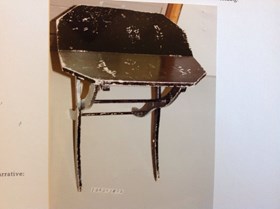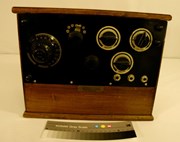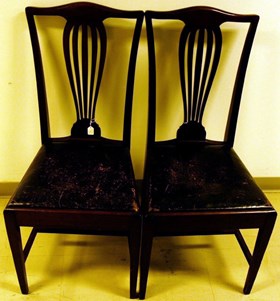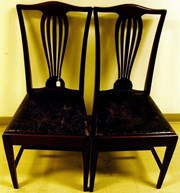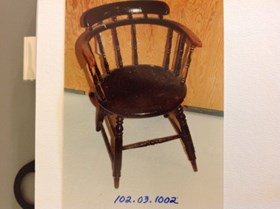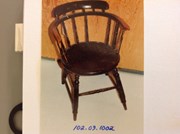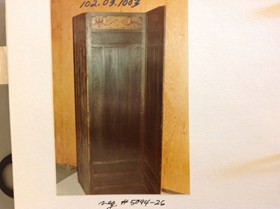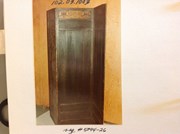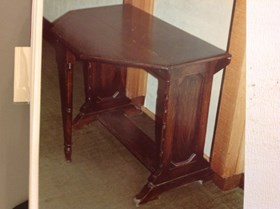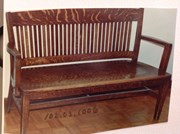Narrow Results By
- Date
- 1930 – 1960
- Material
- wood; metal
- Catalogue Number
- 102.03.1022
- Description
- Low wooden table painted black. Table top hinged in centre to allow folding.
1 image
- Title
- Folding Table
- Date
- 1930 – 1960
- Material
- wood; metal
- Description
- Low wooden table painted black. Table top hinged in centre to allow folding.
- Subject
- households
- furniture
- Credit
- Gift of Catharine Robb Whyte, O. C., Banff, 1979
- Catalogue Number
- 102.03.1022
Images
This material is presented as originally created; it may contain outdated cultural descriptions and
potentially offensive content.
Read more.
Peanut Tube Radio
https://archives.whyte.org/en/permalink/artifact105.04.1016%20a-c
- Date
- 1924
- Material
- wood; metal; plastic; glass; fibre
- Catalogue Number
- 105.04.1016 a-c
- Description
- A peanut tube (three-tube) radio enclosed in a varnished brown wooden box/cabinet (a) with a hinged lid. The lid has two small metal screw eyes on each side of the inside (2.0cm from the corner) attaching it to the cabinet which has two metal hooks (2.0cm down from the front corner) screwed into pl…
1 image
- Title
- Peanut Tube Radio
- Date
- 1924
- Material
- wood; metal; plastic; glass; fibre
- Dimensions
- 26 x 18 x 32.5 cm
- Description
- A peanut tube (three-tube) radio enclosed in a varnished brown wooden box/cabinet (a) with a hinged lid. The lid has two small metal screw eyes on each side of the inside (2.0cm from the corner) attaching it to the cabinet which has two metal hooks (2.0cm down from the front corner) screwed into place on both sides. These are used to close the lid securely to the main cabinet. A paper diagram of the circuitry board is tacked to the obverse side of the lid with six metal thumbtacks. The diagram outlines the blueprint of the radio (b), which is separate from the cabinet; the radio slides out of the front from two grooves cut into the sides of the cabinet. The cabinet has two holes bored into the back to attach it to a wall. The front of the radio has a plastic panel secured in place to the base, which is a flat piece of wood, by the dials etc. and four screws on the bottom. Extreme left in the top and bottom corner are two small black plastic knobs; the top knob is the antennae, the bottom is the ground knob. In between these to the middle left is a large plastic knob, black with degrees marked in white, adjustable control (0 increasing by 10’s to a 100 degrees) for station tuning; the small knob in centre (starting at 0 increasing by 5 degrees to 2, then 3, both left and right) is for fine tuning. Next, to the top right is an adjustable black knob with a bent metal contact piece attached; it moves left and right moving to make contact with five metal posts used for switching to different radio bands; two metal posts, one at either end, are used to keep the metal contact piece within the five contact points radius. Below this is a plain black plastic adjustable knob used for sensitivity control for the strength of radio station waves. This goes in and out, further and closer, (it is attached to wires covered with a textile). To the right of these are three black plastic knobs adjustable rheostats (that control the filaments of the three tubes inside (R215-A Vacuum tube); this is the volume control. Three nuts (jack has a thread on it to keep in place) are for jacks for headphone output. Jack 3, closest to the edge of the radio, also controls the switch to the speaker (if you want to have a speaker hooked up to loudspeaker). There are two wires attached different colours; they have a sleeve on the corners so it doesn’t short-circuit.The headphones (c) are hard plastic earpieces (6 cm. in diametre); one has a metal back with “FROST (F)ONES NO. 161 1000” , and three screws underneath the lettering; the other is black hard Bakelite plastic with “National” written in script ,“ELECTRIC” in the tail of the L, underneath that “OHMS 100C SINGLE”, two screws and nuts attaching two-fibre covered wires on either side that connect to the plastic and metal jack plug, “MNFD. BY THE NATIONAL ELECTRIC HEATING COMPANY LIMITED TORONTO CANADA”. Each earpiece has a metal piece attached by rivets to each side allowing it to move. The two-band fibre-covered headpiece is connected to the metal piece by two metal wires. The two fibre-cover wires extending from the earphones are joined and covered with a black cord wound around until it forms a loop which is knotted to close. Two plugs that fit into the jack attachment BARKEKLEW SERIESPAT. PENDING NUMBERS 1,2,3,4, negative on the left side and positive on the right making 8 hole plugs, 2 screws in the place attaching to the metal jack that plugs into the radio.Blueprint hand drawn for back.
- Subject
- households
- furniture
- entertainment
- Credit
- Gift of Lorne Cooley, Banff, 2008
- Catalogue Number
- 105.04.1016 a-c
Images
This material is presented as originally created; it may contain outdated cultural descriptions and
potentially offensive content.
Read more.
- Date
- 1890 – 1910
- Material
- wood; skin; horse hair; fabric; metal
- Catalogue Number
- 102.03.0301 a,b
- Description
- Two elegant dining room hardwood chairs of Chippendale design with seats covered in black leather. The chairs have a gracefully curved and crested rail that is a separate piece which is glued to the slat back and the curved back frame. The slat backs with a lyre-shaped (five cut-out slats from one …
1 image
- Title
- Dining Chair
- Date
- 1890 – 1910
- Material
- wood; skin; horse hair; fabric; metal
- Dimensions
- 97.3 x 46.0 cm
- Description
- Two elegant dining room hardwood chairs of Chippendale design with seats covered in black leather. The chairs have a gracefully curved and crested rail that is a separate piece which is glued to the slat back and the curved back frame. The slat backs with a lyre-shaped (five cut-out slats from one piece of wood) centre is joined to the frame and the curved rail. The chair seat is narrower at the back becoming wider as it gets to the end so the legs are spaced further apart at the front. The Marlborough-style tapered legs have an H-frame stretcher about three-quarters from the top of the drop-in seat. The leather covered seats have a wood frame (no centre) that fits into rabbets, horsehair filling, and an undercover in muslin cotton fabric. The four corner support joints underneath the seat are pieces of wood nailed onto the seat; also a piece of wood nailed and screwed onto both sides of seat bottom.
- Subject
- households
- furniture
- Moore House
- Credit
- Gift of Bruce Horn, Coquitlam, 1999
- Catalogue Number
- 102.03.0301 a,b
Images
This material is presented as originally created; it may contain outdated cultural descriptions and
potentially offensive content.
Read more.
- Date
- 1900 – 1935
- Material
- skin; wood; metal
- Catalogue Number
- 102.03.1001
- Description
- Dr. Brett's octagonal brown leather footstool, short brown leather covered stool with veneered walnut base and 4 round brass feet, padded leather with covered matching tacks and a 1.5 cm strip tojoin to the base, 8 sides, walnut, along bottom of each side are 3 small rectangles of inlaid walnut aga…
1 image
- Title
- Footstool
- Date
- 1900 – 1935
- Material
- skin; wood; metal
- Dimensions
- 13.0 x 27.5 x 27.5 cm
- Description
- Dr. Brett's octagonal brown leather footstool, short brown leather covered stool with veneered walnut base and 4 round brass feet, padded leather with covered matching tacks and a 1.5 cm strip tojoin to the base, 8 sides, walnut, along bottom of each side are 3 small rectangles of inlaid walnut against a mahogany background,
- Subject
- Dr. Brett
- households
- furniture
- Credit
- Gift of Mr. and Mrs. Norman Tabuteau, Banff, 1966
- Catalogue Number
- 102.03.1001
Images
This material is presented as originally created; it may contain outdated cultural descriptions and
potentially offensive content.
Read more.
- Date
- 1890 – 1905
- Material
- wood; metal
- Catalogue Number
- 102.03.1002
- Description
- CPR station master's black oak chair, Windsor-style chair, round seat, horseshoe-shaped arms and back supported by baluster turnings (1 missing) and 2 wires at sides, curved horizontal bar 10.0 cm at back above arms supported by short balustrades, tag, "It was originally used by the Station Master …
1 image
- Title
- Captain Chair
- Date
- 1890 – 1905
- Material
- wood; metal
- Dimensions
- 73.5 x 51.6 x 50.0 cm
- Description
- CPR station master's black oak chair, Windsor-style chair, round seat, horseshoe-shaped arms and back supported by baluster turnings (1 missing) and 2 wires at sides, curved horizontal bar 10.0 cm at back above arms supported by short balustrades, tag, "It was originally used by the Station Master when there was a Railway depot at Bankhead. George Noble used it every day in his home ... he passed away (7/26/65) Margaret (Mrs. G) Noble Sept 3 1965"
- Subject
- CPR
- office
- furniture
- towns
- Bankhead
- characters
- George Noble
- Credit
- Gift of Unknown, 1968
- Catalogue Number
- 102.03.1002
Images
This material is presented as originally created; it may contain outdated cultural descriptions and
potentially offensive content.
Read more.
Folding Screen
https://archives.whyte.org/en/permalink/artifact102.03.1003
- Date
- 1920 – 1935
- Material
- wood; metal
- Catalogue Number
- 102.03.1003
- Description
- large black stained oak folding partition screen, 3 folding sections each consisting of 2 horizontal boards at top, 4 vertical boards in middle, and 3 more horizontal boards at bottom, top board incised with stylized floral and ribbon pattern stained pink and black against green background, screen …
1 image
- Title
- Folding Screen
- Date
- 1920 – 1935
- Material
- wood; metal
- Dimensions
- 174.0 x 3.7 x 151.5 cm
- Description
- large black stained oak folding partition screen, 3 folding sections each consisting of 2 horizontal boards at top, 4 vertical boards in middle, and 3 more horizontal boards at bottom, top board incised with stylized floral and ribbon pattern stained pink and black against green background, screen sections hinged vertically to fold like accordion
- Subject
- households
- furniture
- Credit
- Gift of Unknown, 1968
- Catalogue Number
- 102.03.1003
Images
This material is presented as originally created; it may contain outdated cultural descriptions and
potentially offensive content.
Read more.
- Date
- 1925 – 1940
- Material
- wood; metal
- Catalogue Number
- 102.03.1004
- Description
- varnished wood, branch legs with burl growth, adjustable chair back, (3 positions), made of a cross section of coniferous tree with bark edge intact, two long arm rests, on back of the top of the rests are 4 metal rods attached, a metal rod sits between these to support chair back, arms are low w…
1 image
- Title
- Chair
- Date
- 1925 – 1940
- Material
- wood; metal
- Dimensions
- 81.5 x 64.6 x 80.5 cm
- Description
- varnished wood, branch legs with burl growth, adjustable chair back, (3 positions), made of a cross section of coniferous tree with bark edge intact, two long arm rests, on back of the top of the rests are 4 metal rods attached, a metal rod sits between these to support chair back, arms are low with short branch supports with burl growth, seat is length section of conifer rounded edges, branch legs with burl growth, cross braced with same
- Subject
- households
- furniture
- Credit
- Gift of Unknown, 1968
- Catalogue Number
- 102.03.1004
Images
This material is presented as originally created; it may contain outdated cultural descriptions and
potentially offensive content.
Read more.
Drop Leaf Table
https://archives.whyte.org/en/permalink/artifact102.03.1005
- Date
- 1890 – 1920
- Material
- wood
- Catalogue Number
- 102.03.1005
- Description
- octagonal shaped, drop leaf table, extension leaf is rectangular, 2 drop leafs raise up to be an octagonal shape, swinging gate legs are turned, solid end legs have a plain inset and turned wood on edge, the stretcher is solid wood attached to the feet
1 image
- Title
- Drop Leaf Table
- Date
- 1890 – 1920
- Material
- wood
- Dimensions
- 73.8 x 34.5 x 91.0 cm
- Description
- octagonal shaped, drop leaf table, extension leaf is rectangular, 2 drop leafs raise up to be an octagonal shape, swinging gate legs are turned, solid end legs have a plain inset and turned wood on edge, the stretcher is solid wood attached to the feet
- Subject
- households
- furniture
- Credit
- Gift of Unknown, 1968
- Catalogue Number
- 102.03.1005
Images
This material is presented as originally created; it may contain outdated cultural descriptions and
potentially offensive content.
Read more.
- Date
- 1900 – 1930
- Material
- wood
- Catalogue Number
- 102.03.1006
- Description
- oak bench, open arm rests, slatted back; 29 vertical, flat narrow slats are inset into backrest, long back legs curve from floor to top of backrest, slightly hollow seat is one piece of wood, armrests 24.0 from seat surface, backrest 47.0 high, H-shaped stretchers rounded off corners at back of s…
1 image
- Title
- Settee Bench
- Date
- 1900 – 1930
- Material
- wood
- Dimensions
- 89.0 x 53.0 x 134.7 cm
- Description
- oak bench, open arm rests, slatted back; 29 vertical, flat narrow slats are inset into backrest, long back legs curve from floor to top of backrest, slightly hollow seat is one piece of wood, armrests 24.0 from seat surface, backrest 47.0 high, H-shaped stretchers rounded off corners at back of settee, settee held together with wooden pegs
- Credit
- Gift of Unknown, 1968
- Catalogue Number
- 102.03.1006
Images
This material is presented as originally created; it may contain outdated cultural descriptions and
potentially offensive content.
Read more.
- Date
- 1890 – 1910
- Material
- wood ; skin
- Catalogue Number
- 102.03.0001 a,b
- Description
- Two chairs of Chippendale design with seats covered in black leather. Chair 102.03.0001A is split at top right front along with some scuffing. Chair 102.03.0001B has some scuffs and scratches.
1 image
- Title
- Dining Chair
- Date
- 1890 – 1910
- Material
- wood ; skin
- Dimensions
- 97.3 x 49.0 x 54.0 cm
- Description
- Two chairs of Chippendale design with seats covered in black leather. Chair 102.03.0001A is split at top right front along with some scuffing. Chair 102.03.0001B has some scuffs and scratches.
- Subject
- households
- furniture
- Credit
- Gift of Pearl Evelyn Moore, Banff, 1979
- Catalogue Number
- 102.03.0001 a,b
Images
This material is presented as originally created; it may contain outdated cultural descriptions and
potentially offensive content.
Read more.

